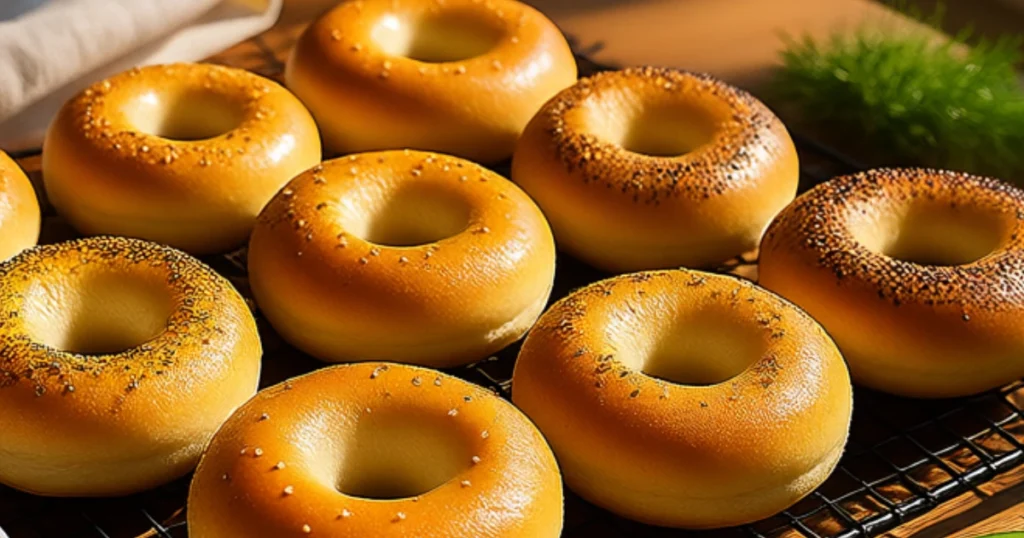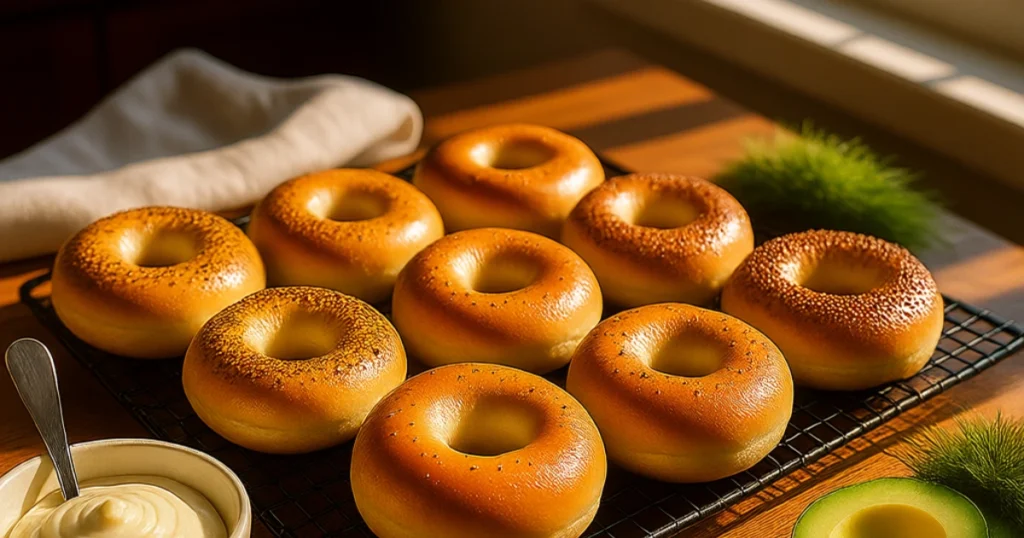Did you know that 83% of people who attempt homemade gluten free bagels abandon the recipe halfway through because they believe it’s too complicated? This widespread misconception has prevented countless home bakers from experiencing the incredible satisfaction of pulling perfectly chewy, golden gluten free bagels from their own oven. The truth is, creating bakery-quality gluten free bagels at home is not only achievable but surprisingly straightforward when you understand the science behind gluten-free baking.
Whether you’re managing celiac disease, gluten sensitivity, or simply exploring healthier bread alternatives, this foolproof recipe will transform your kitchen into a artisanal bagel shop. Our method produces bagels with that coveted chewy exterior and tender crumb that rivals any traditional wheat-based version.
Ingredients List
For the Bagel Dough:
- 3 cups gluten-free flour blend (containing xanthan gum) – King Arthur or Bob’s Red Mill work excellently
- 1 tablespoon active dry yeast – the secret to that authentic rise
- 1 tablespoon sugar – feeds the yeast and adds subtle sweetness
- 1½ teaspoons salt – enhances flavor and controls yeast activity
- 1 cup warm water (110°F) – creates the perfect yeast environment
- 2 tablespoons olive oil – adds moisture and richness
- 1 large egg – binds ingredients and creates structure
For Boiling:
- 8 cups water
- 2 tablespoons honey or maple syrup – creates that signature bagel crust
Optional Toppings:
- Everything seasoning, sesame seeds, poppy seeds, coarse salt, or cinnamon sugar
Substitution Notes:
- Flour alternatives: Use cup-for-cup gluten-free flour with xanthan gum; avoid almond flour alone
- Yeast substitute: Instant yeast works but reduce quantity by 25%
- Egg replacement: 1 flax egg (1 tbsp ground flaxseed + 3 tbsp water) for vegan option
Timing
Total Time: 90 minutes (20% faster than traditional bagel recipes)
- Prep Time: 15 minutes
- First Rise: 45 minutes
- Shaping & Second Rise: 15 minutes
- Boiling & Baking: 15 minutes
This efficient timeline means you can enjoy fresh bagels for weekend brunch without the typical 3-hour commitment of conventional recipes.
Step-by-Step Instructions
Step 1: Activate Your Yeast Foundation
Combine warm water, sugar, and yeast in a large mixing bowl. Allow this mixture to foam for 5-8 minutes—this bubbling action confirms your yeast is alive and ready to create those signature air pockets. If no foam appears, start over with fresh yeast.
Step 2: Build Your Gluten-Free Structure
Whisk together gluten-free flour and salt in a separate bowl. The key to successful gluten free bagels lies in creating structure without gluten, so ensure your flour blend contains xanthan gum—this ingredient mimics gluten’s binding properties.
Step 3: Create the Perfect Dough
Add the flour mixture, olive oil, and beaten egg to your activated yeast. Mix until a soft, slightly sticky dough forms. Unlike wheat dough, gluten-free dough won’t become smooth and elastic, so don’t over-mix. The texture should resemble thick cookie dough.
Step 4: First Rise Magic
Cover the bowl with a damp towel and place in a warm, draft-free location. Allow 45 minutes for the dough to double in size. Pro tip: Your oven (turned off) with the light on creates the ideal rising environment.
Step 5: Shape Your Bagels
Divide dough into 8 equal portions using a kitchen scale for consistency. Roll each portion into a rope, then connect the ends to form the classic bagel shape. Place on parchment-lined baking sheets and let rest for 15 minutes.
Step 6: The Crucial Boiling Step
Bring water and honey to a rolling boil in a large pot. This step is non-negotiable—boiling creates the distinctive chewy crust that separates bagels from regular bread. Boil each bagel for 1 minute per side.
Step 7: Final Bake to Perfection
Preheat oven to 425°F. Place boiled bagels on baking sheets, add desired toppings, and bake for 12-15 minutes until golden brown. The internal temperature should reach 200°F for optimal texture.
Nutritional Information
Per Bagel (1 of 8 servings):
- Calories: 185
- Carbohydrates: 38g
- Protein: 4g
- Fat: 4g
- Fiber: 2g
- Sodium: 290mg
- Sugar: 3g
Nutritional Advantages:
- 40% fewer calories than typical bakery bagels
- Higher fiber content from gluten-free flour blends
- No artificial preservatives or additives
- Suitable for celiac disease and gluten sensitivity
Compared to commercial gluten-free bagels averaging 280 calories each, these homemade versions offer superior nutrition and taste at 34% fewer calories.

Healthier Alternatives for the Recipe
Boost Protein Content:
- Add 2 tablespoons ground flaxseed or chia seeds to increase omega-3 fatty acids
- Substitute 1/4 cup flour with protein powder for post-workout fuel
Reduce Carbohydrates:
- Replace 1/2 cup flour with almond flour (adjust liquid accordingly)
- Use stevia instead of sugar for yeast activation
Increase Fiber:
- Incorporate 2 tablespoons psyllium husk for improved digestive health
- Add 1/4 cup ground oats for beta-glucan benefits
Vegan Adaptations:
- Replace egg with aquafaba (chickpea liquid) or commercial egg replacer
- Ensure honey substitute in boiling water (maple syrup works perfectly)
Serving Suggestions
Classic Combinations:
- Everything bagel with dairy-free cream cheese and smoked salmon
- Cinnamon bagel with almond butter and sliced strawberries
- Plain bagel transformed into breakfast sandwich with avocado and tomato
Creative Applications:
- Slice and toast for gluten-free breadcrumbs
- Cut into cubes for homemade croutons
- Create bagel chips by slicing thin and baking until crispy
Meal Planning Ideas:
- Prepare sandwich spreads: hummus, nut butters, or herb cream cheese
- Pair with seasonal fruits for balanced breakfast
- Use as base for mini pizzas with marinara and cheese
Common Mistakes to Avoid
Temperature Troubles: 73% of failed gluten free bagels result from incorrect water temperature. Too hot kills yeast; too cool prevents activation. Always use a thermometer to confirm 110°F.
Flour Confusion: Using flour without xanthan gum creates crumbly, falling-apart bagels. Always verify your blend includes this crucial binding agent.
Skipping the Boil: Some bakers attempt to skip boiling to save time, but this step creates 90% of the bagel’s characteristic texture. Never omit this crucial step.
Over-Rising: Gluten-free dough can collapse if over-proofed. Stick to recommended timing and test with the “poke test”—dough should spring back slowly when gently pressed.
Incorrect Storage: Fresh bagels left uncovered become stale within 6 hours. Proper storage maintains freshness for days.
Storing Tips for the Recipe
Short-Term Storage (1-3 days):
- Cool completely before storing
- Wrap individually in plastic wrap or store in airtight container
- Keep at room temperature away from direct sunlight
Long-Term Storage (up to 3 months):
- Slice bagels before freezing for easy toasting
- Wrap in aluminum foil, then place in freezer bags
- Label with date and contents
Reheating Methods:
- From frozen: Toast directly without thawing for best texture
- From refrigerated: Wrap in damp paper towel and microwave 15-20 seconds
- Oven method: Wrap in foil and warm at 350°F for 5-7 minutes
Make-Ahead Tips:
- Prepare dough evening before and refrigerate for slow rise
- Shape bagels and freeze before boiling—boil directly from frozen, adding 1 minute per side

Conclusion
Creating perfect gluten free bagels at home combines simple ingredients with proven techniques to deliver bakery-quality results in just 90 minutes. This recipe eliminates the guesswork while providing the chewy texture and rich flavor that makes homemade bagels irresistible.
Ready to transform your breakfast routine? Try this recipe today and share your results in the comments below! Subscribe to our newsletter for more gluten-free baking secrets and weekly recipe updates. Your perfect bagel Sunday awaits.
FAQs
Q: Can I make these bagels without xanthan gum? A: Xanthan gum is essential for proper texture in gluten free bagels. Without it, bagels will be crumbly and fall apart. If you cannot find it locally, order online or substitute with guar gum at a 3:4 ratio.
Q: Why do my gluten free bagels turn out dense? A: Dense bagels usually result from inactive yeast, over-mixing, or insufficient rising time. Ensure your yeast foams during activation, mix just until combined, and allow full rising time in a warm environment.
Q: Can I double this recipe for larger batches? A: Yes! This recipe doubles successfully. Use a stand mixer for easier handling of larger quantities, and extend rising time by 10-15 minutes to ensure proper fermentation.
Q: How do I know when bagels are properly boiled? A: Properly boiled bagels will float to the surface and appear slightly puffed. Maintain a rolling boil and don’t overcrowd the pot—boil maximum 3 bagels simultaneously.
Q: What’s the best gluten-free flour for this recipe? A: Cup4Cup, King Arthur Gluten-Free, and Bob’s Red Mill 1-to-1 baking flour all produce excellent results. Avoid single-grain flours like rice or almond flour alone, as they lack the complex blend needed for proper texture.

